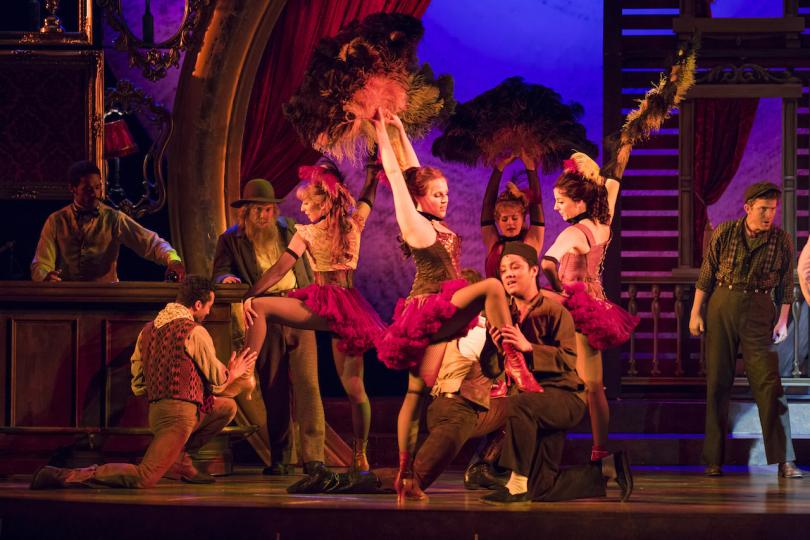Reviving Old Musicals: Lerner and Loewe

According to theater legend, Alan Jay Lerner (1918-1986) and Frederick Loewe (1901-1988) met at a party and three weeks later, their first collaboration, The Life of the Party went into production (it closed on the road). Their next two collaborations, What’s Up? (63 performances) and The Day Before Spring (167 performances) have essentially fallen into obscurity. However, while Rodgers and Hammerstein were experimenting with the form, Lerner and Loewe created one of the authentic jewels of musical theater!
Once in the Highlands
Brigadoon takes us to the Scottish highlands, where Americans Tommy Albright and Jeff Douglas are hunting. They happen upon the village of Brigadoon, which, due to an ancient wish, appears for only one day every century. It’s a busy day because, as well as a street fair, it’s the wedding day for Charlie Dalrymple and Jean MacLaren. Jean’s spurned suitor, Archie Beaton, holds a grudge and has plans for revenge. Tommy falls in love with Fiona and faces a dilemma: to choose between disappearing into the midst with Fiona or returning to his vapid fiancee in America. The exceptional, lilting score includes “Almost Like Being in Love,” “I’ll Go Home with Bonnie Jean,” and “The Heather on the Hill.”
With a cast that included David Brooks as Tommy, radio star Marion Bell (who would become the second of Lerner’s eight wives) as Fiona, popular Broadway dancer James Mitchell as Archie and comedienne Pamela Britton as Meg Brockie, Brigadoon was the highlight of the season. The Tony Awards were first given a year later, but had they been around in 1947, it’s certain that Brigadoon would have taken the top musical awards.
Following its opening, Lerner went to Hollywood, where his screenplay for An American in Paris earned him an Oscar and he collaborated with Burton Lane on Royal Wedding starring Fred Astaire and Jane Powell. Brigadoon is Lerner and Loewe’s only original stage musical to be filmed at MGM.
The 1954 film was strongly criticized, mostly because it wasn’t filmed in Scotland; however Vincente Minnelli and Gene Kelly had scouted locations there, only to realize that high winds and frequent changes in precipitation would cause delays. In spite of flaws, the movie is pretty good. Kelly gives his standard performance (he also created the dances), but Cyd Charisse gives one of her finest performances as Fiona and Jeff Douglas is one of Van Johnson’s better screen roles. Sadly the film eliminates about half of the score. (The Sword Dance, There But for You Go I and Come to Me, Bend to Me were filmed and are featured in the extras on the DVD release). An Emmy Award-winning television production starring Robert Goulet, Peter Falk and Sally Ann Howes was presented in 1966. Trimmed to about 70 minutes, it’s available on You Tube.
Brigadoon was once a staple of high school, college and community theaters, but is seldom produced today. In 2014, I saw a thrilling revival at Chicago’s Goodman Theater. It featured a revised libretto by Brian Hill (The Story of My Life), retaining the 1947 setting, and adding the British Parliament’s Act of Proscription as a suplot for the village’s disappearance. This Act put an end to Clan revolt, forbade the wearing of Tartans, and Scots were required to follow British rule.
Hill recreates Tommy as a war-weary Vet, searching for some purpose to his life, which strengthens this role, and makes Tommy’s ultimate decision more poignant. Brigadoon is a beautiful musical and one that continues to enchant audiences, no matter how many times it’s presented. It’s time for a Twin Cities revival.
Gold in Them Thar Hills
Lerner and Loewe returned to Broadway with Paint Your Wagon a story of the California Gold Rush. The original plot follows Ben Rumson, and his daughter Jennifer, who arrive at a mining camp, a place with too many men and too few women. After he strikes it rich, Ben plans on sending Jennifer back east to school, but she’s fallen in love with Julio, a Latino miner. Songs from this rough and tumble show include “Wand’rin Star,” “I Talk to the Trees,” and “They Call the Wind Maria.” James Barton, Olga San Juan, the previously mentioned James Mitchell and Kay Medford (Funny Girl) starred on Broadway where, in 1951, it played 289 performances and then moved to London where its run was almost doubled.
If you think you know Paint Your Wagon from Joshua Logan’s 1969 film version, you don’t know the show at all. For the movie Lerner wrote a new script based on a treatment by Paddy Chayevsky. Filmed at a time when the studios were making unsuccessful multimillion-dollar musicals with non-singing stars such as Rex Harrison in Dr. Doolittle, Peter O’Toole in Goodbye Mr. Chips and Man of La Mancha and Liv Ullmann in Lost Horizon, Paint Your Wagon starred Lee Marvin, Jean Seberg, Harve Presnell and Clint Eastwood (who, surprisingly, sings rather well). In spite of his gravelly voice, Marvin had a top-ten hit with “Wand’rin’ Star” (in the United Kingdom).
The film version follows Rumson (Marvin) and Pardner (Eastwood) who share a claim and establish No-Name City. A Mormon arrives and because he no longer has any use for one of his two wives, auctions Elizabeth, to the highest bidder. Ben wins and marries her, but the feisy woman falls in love with Pardner. As time goes on, complications arise and Ben decides to leave so he can follow his “Wand’rin Star.”
Twin Cities audiences have the opportunity of seeing Paint Your Wagon with a revised libretto by Jon Marons (The Tempermentals, Old Wicked Songs) this August. Arriving almost immediately after it’s 5th Avenue Theater engagement in Seattle and starring Broadway’s original Jekyll/Hyde, Robert Cuccioli, this exciting show is a remarkable contribution to the local scene. The 5th Avenue Theater production is dazzling. Several elements from the previous scripts have been retained, but this revision is a fine accomplishment on its own. While Marons’ script raises issues that aren’t settled (and in musical theater terms, if they were, the script wouldn’t work), the show is a better show than some of the recent revisions. (See my comments in a previous column about Pal Joey.)
Le Belle Epoque
In 1956, Lerner and Loewe’s My Fair Lady, one of the milestones of musical theater, arrived on Broadway. It was the longest-running show until its 2,717 performances were surpassed by Hello, Dolly!, Fiddler on the Roof, and much later, The Phantom of the Opera.
Subsequently, MGM offered Lerner and Loewe the opportunity to create an original screen musical, and Gigi, is one of the all-time best. Adapted from a novella by Colette, it was directed by Vincente Minnelli, designed by Cecil Beaton and shot in Paris at such locations as Maxim’s, The Ice Palace and the Bois de Bologne. Its one-of-a-kind cast featured Leslie Caron, Maurice Chevalier, Hermione Gingold, Louis Jourdan and Isabel Jeans. The film won eight Academy Awards including Best Picture of 1958.
Set at the beginning of the 20th Century during a time known as Le Belle Epoque and narrated by Honore Lachaille (Chevalier), Gigi is the story of a young lady who’s being groomed by her Mamita (Gingold) and Aunt Alicia (Jeans) to go into the family business as a courtesan. However, she’s in love with her old friend, bon vivant Gaston Lachaille (Jourdan) and manages to alter her fate, making a better choice than her elders.
After the phenomenon of My Fair Lady, and the lesser success of Camelot, Loewe retired to sail his yacht around the Mediterranean, but Lerner convinced him to score four new songs for the stge version of Gigi, “Paris is Paris Again”, “In This Wide, Wide World”, “The Gossips” and “The Contract”, while eliminating two from the film score: “The Parisians” and “Say A Prayer for Me Tonight.” (The latter had been cut from My Fair Lady.)
The first stage version lasted 103 performance, winning the Tony for Best Score, because it hadn’t been heard onstage before. A stock package was arranged and toured the following summer, while, a decade later, Jourdan, this time playing Chevalier’s role took it on tour. While collaborating on Gigi, Lerner also persuaded Loewe to write music for a film version of the classic French tale, The Little Prince.
Gigi returned to the stage in 2015. Heidi Thomas created a reimagined libretto that reassigned some of the songs to different characters. Gigi’s age was raised from 15 to 18, so her attraction to 30-year-old Gaston isn’t as startling. The songs from the 1973 version, which seemed to interrupt the plot, are better integrated into the show and now enhance the story. Honore still narrates the proceedings, but his opening number, “Thank Heaven for Little Girls” has been moved to a later scene where it’s sung by Mamita, while “The Night They Invented Champagne” becomes the First Act Finale. Along with the ever charming duet “I Remember It Well,” Mamita and Honore also perform “I’m Glad I’m Not Young Anymore” as a counterpoint. If the new cast recording is evidence, it’s now a better show. While it only played 10 weeks on Broadway, a National Tour is planned, followed by licensing from Tams-Witmark.
Lerner Without Loewe
Unwilling to let go, Lerner continued to work, but only two of his later works were successful. One of them, Coco, was about French designer Coco Chanel and her comback in the early 1950s. It was written with Andre Previn (who also collaborated with Lerner on the film version of Paint Your Wagon) and became a qualified hit because Katharine Hepburn made her only musical appearance as Chanel.
Lolita My Love, written with John Barry and based on the Nabokov novel, closed on the road; 1600 Pennsylvania Avenue, written with Leonard Bernstein, lasted a week, but Bernstein later redeveloped his score into a Suite to honor the Bicentennial; Carmelina, with a score by Burton Lane, lasted two weeks, but its plot would be used again for the international success, Mamma Mia!, the most popular jukebox musical of all time. Based on the play Idiot’s Delight (to be produced this season at Park Square), the musical Dance A Little Closer, written with Charles Strouse, opened and closed on the same night, thus earning the nickname Close a Little Faster.
On a Clear Day I Picked a Daisy
In my article on Rodgers Without Hammerstein, I mentioned that Lerner was planning to work with Richard Rodgers on a show titled I Picked A Daisy. However, scheduling collaborative time became such a chore that Rodgers bowed out. Working again with Burton Lane, the show was produced as On a Clear Day You Can See Forever.
Based In part, on the play Berkeley Square, Daisy Gamble is a woman with ESP, who makes flowers grow by talking to them, predicts telephone calls and anticipates where objects are hidden. She visits Doctor Mark Bruckner hoping to be hypnotized so she’ll stop smoking to please her square peg fiance, Warren. Under hypnosis, Bruckner discovers that Daisy remembers past lives, specifically during Britain’s Empire Period, when she was Melinda Wells. Melinda was accused of treason and sentenced to death. Bruckner finds himself falling in love with Melinda. Daisy tells him to “stop using my head for a motel,” when its revealed due to recording their sessions. Realizing they’re wrong for one another, Daisy rejects Warren, while Bruckner reminds her that she’s special and doesn’t need healing. The luscious, magical score also includes the title song, Hurry! It’s Lovely Up Here, Come Back to Me and Wait ‘Til We’re 65.
John Cullum (Shenandoah, who replaced Louis Jourdan on the road), the delightful Barbara Harris (Robert Altman’s Nashville) and William Daniels (St. Elsewhere) played the Doctor, Daisy/Melinda and Warren on Broadway. It was a hit largely due a sale to Paramount Pictures. With the master of the cinematic musical, Vincente Minnelli, and period costumes by Cecil Beaton, it starred Barbra Streisand, Yves Montand and Jack Nicholson. Alas, the movie is broadcast infrequently and isn’t available on disc.
Five years ago, the show received it’s first revival with a new libretto by Peter Parnell and directed by Michael Mayer (Spring Awakening, American Idiot). This time the story centered on David (Davey) Gamble, a gay man who works in a flower shop. He wants to quit smoking for his boyfriend, Warren. Under hypnosis, it’s discovered that in a recent past life, he was a Jazz Singer named Melinda Wells. The new version, set in the late 1960s, uses songs from the film and from Royal Wedding. With Harry Connick, Jr. as Dr. Bruckner, David Turner as Davey and Jessie Mueller (Tony winner for Beautiful), the revised On a Clear Day You Can See Forever played through the holiday season (I liked it so much I saw both that, and the revival of Follies each twice!)
As I’ve explored these musicals I’ve learned that Lerner wasn’t the great librettist he fancied himself to be. All of Lerner and Loewe’s musicals, except My Fair Lady, have been tinkered with in recent years. Still, the thought of being in a performance space where the intelligent lyrics of Alan Jay Lerner and the pleasing music of Frederick Loewe or Burton Lane fill your ears with songs like “Almost Like Being in Love,” “The Heather on the Hill,” “They Call the Wind Maria,” “Paris is Paris Again,” “Thank Heaven for Little Girls,” “The Night They Invented Champagne” “On a Clear Day You Can See Forever,” or “Come Back to Me” is incentive enough to spend some time in the theater. The opportunity of seeing these classic, yet seldom presented musicals is another. Consider these works of Lerner, Loewe and Lane when planning your season’s musicals.




